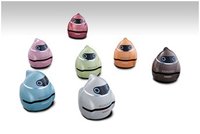Collision-free driving by mimicking fish behaviour
 In 2008, it was the flight of the bumblebee that inspired Nissan’s Biomimetic Car Robot Drive “BR23C” concept. In 2009, fish-inspired technology takes center stage in Nissan Motor Co., Ltd’s new Nissan “EPORO” robot car concept, which is designed to travel in a group of like-vehicles, mimicking the behavioral patterns of a school of fish in avoiding obstacles without colliding with each other.
In 2008, it was the flight of the bumblebee that inspired Nissan’s Biomimetic Car Robot Drive “BR23C” concept. In 2009, fish-inspired technology takes center stage in Nissan Motor Co., Ltd’s new Nissan “EPORO” robot car concept, which is designed to travel in a group of like-vehicles, mimicking the behavioral patterns of a school of fish in avoiding obstacles without colliding with each other.Nissan will demonstrate this breakthrough technology with a group of six EPOROs when they make their world debut at the CEATEC JAPAN 2009, October 6 – 10 at the Makuhari Messe.
CEATEC JAPAN is an annual exhibition showcasing cutting-edge electronic and information technologies. Nissan is the only auto manufacturer that has been a participant in this exhibition since 2006. In addition to displaying the futuristic EPORO, Nissan Senior Vice President Minoru Shinohara will deliver a keynote speech, titled “The Future of the Automobile with Electric Vehicles and Car Robotics Evolution,” and participate in a panel discussion on “EV leads to a society of ‘All Electrification’ and ‘All Mobilisation.’” Nissan will also exhibit the new Skyline Crossover’s current collision prevention technologies and provide test drives of an eco-drive diagnosis system utilising an iPhone application.
EPORO Robot Car
So what do a bumblebee and a school of fish have in common? Both demonstrate extraordinary “anti-collision” abilities, navigating instinctively and intelligently through challenging terrain by detecting and avoiding obstacles – just as future Nissan safety vehicles may have the capability to do. But where bees – and the BR23C robot car – are likely to travel alone, the schooling behavior of fish, or a group of vehicles, presents a far greater challenge in terms of collision avoidance. In developing EPORO, three rules of fish behavior were applied to its driving control.
Generically, fish recognise the surroundings based on lateral-line sense and sense of sight and form schools based on three behavior rules. A laser range finder is used for lateral-line sense, while UWB communications technology is utilised for the sense of sight.
“We, in a motorised world, have a lot to learn from the behavior of a school of fish in terms of each fish’s degree of freedom and safety within a school and high migration efficiency of a school itself. In EPORO, we recreated the behavior of a school of fish making full use of cutting-edge electronic technologies,” said Toshiyuki Andou, Manager of Nissan's Mobility Laboratory and principal engineer of the robot car project. “By sharing the surrounding information received within the group via communication, the group of EPOROs can travel safely, changing its shape as needed.”
This is the world’s first development of a robot car that can travel in a group by sharing the position and information of others within a group via communication technologies.
While Nissan’s ongoing research aims at creating collision-free vehicles based on its safety concept “Safety Shield,” new technologies used in EPORO also aim to improve migration efficiency of a group of vehicles and contribute to an environmentally friendly and traffic jam-free driving environment.

